|







Contact the Web Master | |
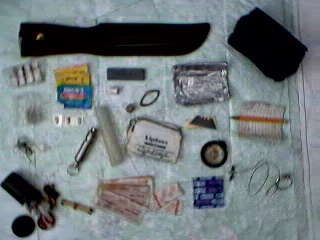 |
When venturing into the wilderness, it's important to be prepared for any situation.
It is quite easy to find yourself in a situation where you are lost, or unable to get to civilization.
As a matter of fact, a friend of mine recently found himself disoriented while
on a day trip. He had paddled up a river, and when leaving, made a wrong turn and couldn't find his way back to the main
lake. It took him several hours, and the help of some canoeist that happened to be
paddling by to find his way back to our base camp.
The really frightening part was that all he had was the bare minimum of safety equipment with him -- a PFD, paddle, bailer,
compass, map and whistle. Thank goodness for the whistle for he was able to attract the attention of the canoeists with it.
If it wasn't for the canoeists, he would have been in a great deal of trouble.
He finally came back to us in the dark, very tired, and quite shaken up.
We all learned a valuable lesson that day.
With that in mind, here's what Mark Hammar takes with him whenever he takes to the woods. With this kit, he could have
made a camp, and kept warm at least until light came, and he could strike out for base camp in daylight. |
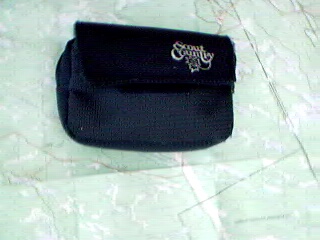 |
The Bag
Everything should pack into a bag that's easy to carry. This bag is about 6 inches long, 3 inches wide and 3 inches deep.
Everything, with the exception of the knife fits neatly into the bag. Any bag will work -- a small fanny pack, or military belt
pouch will work well. Just make sure that it is small and easy to carry -- there's no sense making it so big that you don't want
to carry it with you. |
 |
Matches waterproofed with nail polish - This is the cheapest way I know to get waterproof matches.
Take the strike anywhere matches and paint the tips with nail polish.
Not only does this protect the matches from water (they can be lit after soaking
them in a stream), but it allows you to match your survival items to your wardrobe.
Candle - This it the 6" stub of a regular taper candle. This is important for those times when the tinder you are using to light
your fire is wet, and a match just isnít going to last long enough to get it going. The candle does the job.
flint & steel kit - This is a film canister which is stuffed with dryer lint.
It also contains a steel (piece of saw blade) and a flint (small piece of wood with a slit cut with the blade and 5 lighter flints epoxied in place). If you run out of matches of find that you have some time on your hands this worked well. |
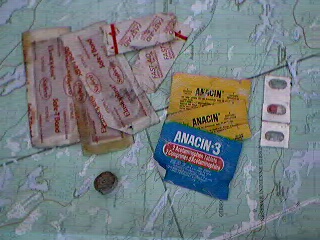 |
Bandages - I carry two types of bandages, normal and butterfly.
The normal bandages are easy to come by and are good for standard cuts.
The butterfly bandages are more for open gashes and have been used instead of stitches to hold closed these
cuts when necessary. Iíd rather have these than try to stitch either myself or someone else if lost in the woods.
Anacin & Benadryl - Medicine for headaches and allergies.
The last thing you need when you are lost in the woods is a mammoth headache blurring your thinking.
Enough said. |
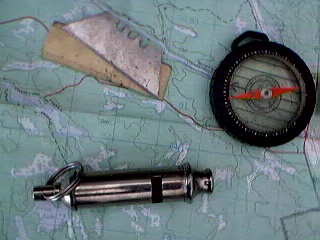 |
compass - Because you donít need to get more lost.
If you are going to attempt to walk out of being lost you need to keep in a straight line because you will eventually be out of the trees.
If you donít use the compass all people will walk in large circles, since everyone has one leg which has a more powerful stride.
Whistle - When you need to signal to the outside world to try to get rescued you may lose your voice, but as long as you can
breathe you can use a whistle for signaling. Very important, especially in an unknown area when I remove it from the survival
kit and wear it around my neck.
blade (covered) - This is a small blade for use in cutting string when building shelter.
It is mostly there incase you lose your knife. |
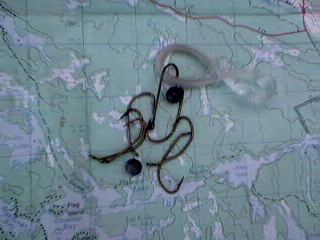 |
Fishing kit - Another small kit with line, hooks, & sinkers.
Sticks can be used to rig a pole and bobber. You can also use a version of the classic dangle snare for this purpose, with the hook in the water instead of a snare loop over a rabbit run. |
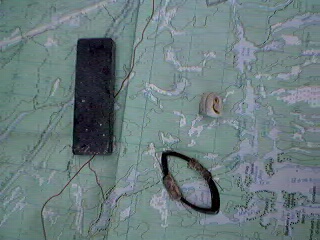 |
Sharpening Stone - This is a small stone for sharpening your knife.
Useful if you are expecting to use your knife for cutting branches to build a shelter, then expect to use it to split wood for the fire, then want to use it to cut wood for snares, etc.
snare wire - I use piano wire for this purpose.
There are 3 different types of snare, strangle, dangle and mangle, this is used in
2 of the three types. Remember, snares are illegal to use unless they are in a survival situation. Donít try this in your backyard
as you will likely capture a neighbourhood pet.
Roll of dental floss - Although this seems stupid, you are not likely to find a string that comes so compact and has such a
great tensile strength. Use this to fasten up poles for a shelter. |
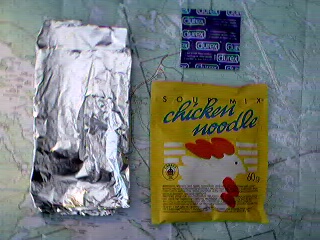 |
3 pack of cup a soup - You can substitute this with bouillon cubes, but I find that the soup takes up the same amount of
space, and I like the noodles.
2 Large squares of tinfoil (folded) - Tinfoil comes in handy all the time for making cooking pots, and even to reflect the sun for
signaling. The later is the most important since this is the only way I have left for purifying water for drinking and cooking.
I donít trust the Halazone tablets since they expire quickly and I wouldnít want to risk using an expired tablet and becoming
sick as well as lost.
Condom - These are great to include since they are invaluable for carrying water (they hold a couple of liters if I am not
mistaken). Make sure you get the non-lubricated variety. |
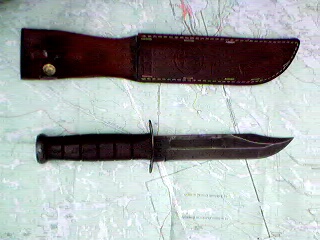 |
Sheath Knife - This is probably the most important part of my kit.
It is a replica of the WWII USMC KABAR Knife I picked up at House of Knives.
Although I have heard many people mock me for having a knife this big (6" blade), I find that it is nice to
have since it has a good weight and can double as a small hatchet for building shelters.
It is also very intimidating. |
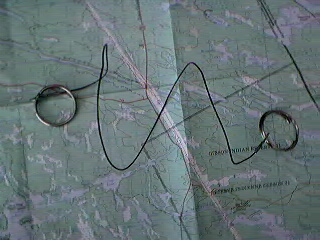 |
wire saw - Although I donít think this is necessary I was given one as a gift and thought there was no harm in including it. |
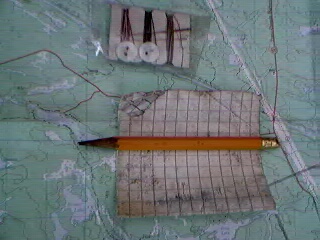 |
Sewing kit - A small kit with needles, thread and buttons.
This is important especially in winter situations. Since skin will freeze quickly it is important to replace any missing buttons or sew any torn clothing right away before frostbite occurs.
Paper and pencil - I happen to have acquired some waterproof paper from a notebook I was given when taking a university
course which required going diving in Jamaica (tough credit). This paper is impregnated with plastic and can even be written
on under the water with a pencil. Although you donít need waterproof paper, regular paper is a good idea.
Apart from the obvious use in fire lighting, it is also important to record the vital information of any injured member of your group who may
need medical treatment when you are rescued. This could save valuable time later. |
|